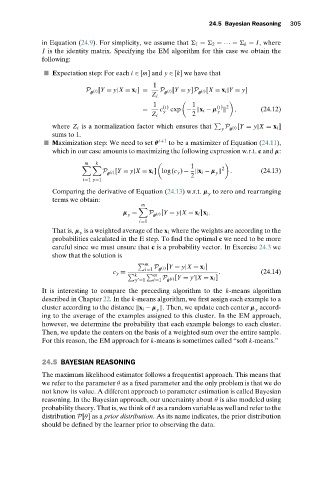Page 323 - Understanding Machine Learning
P. 323
24.5 Bayesian Reasoning 305
in Equation (24.9). For simplicity, we assume that 1 = 2 = ··· = k = I, where
I is the identity matrix. Specifying the EM algorithm for this case we obtain the
following:
Expectation step: For each i ∈ [ m] and y ∈ [ k] we have that
1
P (t) [ Y = y|X = x i ] = P (t) [ Y = y] P (t) [ X = x i |Y = y]
θ θ θ
Z i
1 ( t) 1 ( t) 2
= c y exp − x i − µ , (24.12)
y
Z i 2
where Z i is a normalization factor which ensures that y P (t) [ Y = y|X = x i ]
θ
sums to 1.
Maximization step: We need to set θ t+1 to be a maximizer of Equation (24.11),
which in our case amounts to maximizing the following expression w.r.t. c and µ:
m k
1 2
P (t) [ Y = y|X = x i ] log(c y ) − x i − µ . (24.13)
θ 2 y
i=1 y=1
Comparing the derivative of Equation (24.13) w.r.t. µ to zero and rearranging
y
terms we obtain:
m
µ = P (t) [ Y = y|X = x i ]x i .
y
θ
i=1
That is, µ is a weighted average of the x i where the weights are according to the
y
probabilities calculated in the E step. To find the optimal c we need to be more
careful since we must ensure that c is a probability vector. In Exercise 24.3 we
show that the solution is
m
i=1 P (t)[Y = y|X = x i ]
θ
k m
c y = . (24.14)
y =1 i=1 P (t)[Y = y |X = x i ]
θ
It is interesting to compare the preceding algorithm to the k-means algorithm
described in Chapter 22.In the k-means algorithm, we first assign each example to a
cluster according to the distance x i −µ . Then, we update each center µ accord-
y
y
ing to the average of the examples assigned to this cluster. In the EM approach,
however, we determine the probability that each example belongs to each cluster.
Then, we update the centers on the basis of a weighted sum over the entire sample.
For this reason, the EM approach for k-means is sometimes called “soft k-means.”
24.5 BAYESIAN REASONING
The maximum likelihood estimator follows a frequentist approach. This means that
we refer to the parameter θ as a fixed parameter and the only problem is that we do
not know its value. A different approach to parameter estimation is called Bayesian
reasoning. In the Bayesian approach, our uncertainty about θ is also modeled using
probability theory. That is, we think of θ as a random variable as well and refer to the
distribution P[θ]as a prior distribution. As its name indicates, the prior distribution
should be defined by the learner prior to observing the data.

